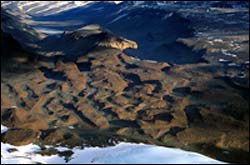
British scientists have discovered rivers the size of the Thames in London flowing hundreds of miles under the Antarctica ice shelf by examining small changes in elevation, observed by ESA’s ERS-2 satellite, in the surface of the oldest, thickest ice in the region, according to an article published in Nature this week.
The finding, which came as a great surprise to the scientists, challenges the widely held assumption that subglacial lakes evolved in isolated conditions for severa
Through a project supported by the European Space Agency, the UK-based company Wired Ocean Ltd can now provide enhanced Internet access for ships at sea at a much lower cost than was previously possible.
Although satellite links at sea are quite common, the speed of data transmission for most users is very low, from 600 bps to 64 kbps, with around 10 kbps being a typical speed. This, combined with usage costs of around € 20 per megabyte, has created an environment in which many s
Expedition achieves milestone in analyzing atmospheric chemistry
A research consortium funded by the National Science Foundation (NSF) and led by the Scripps Institution of Oceanography at the University of California, San Diego, has successfully sent a fleet of aerial drones through the pollution-filled skies over the Indian Ocean, thereby achieving an important milestone in the tracking of pollutants responsible for dimming Earth’s atmosphere.
The instrument-bearing
Plans to drill deep beneath the frozen wastes of the Antarctic, to investigate subglacial lakes where ancient life is thought to exist, may have to be reviewed following a discovery by a British team led by UCL (University College London) scientists at the Natural Environment Research Council (NERC)Centre for Polar Observation and Modelling (CPOM).
In a Letter to Nature they report that rivers the size of the Thames have been discovered which are moving water hundreds of mile
Dutch researcher Yvonne van Breugel analysed rocks from seabeds millions of years old. Carbon occurs naturally in two stable forms; atomic mass 12 (99 percent) and atomic mass 13 (1 percent). Episodes in the Jurassic and Cretaceous periods were characterised by a relatively strong increase in 12C. The analyses have shown that this was caused by a sudden large-scale release of carbon from stocks stored in the ocean floor or peats and bogs.
The atmospheric carbon dioxide concentratio
Scripps-led Project Achieves Milestone in Analyzing Pollutants Dimming the Atmosphere
Technology behind unmanned aerial vehicles proves successful for flying beneath, above and through clouds to trace pollution particles
A scientific research consortium led by Scripps Institution of Oceanography at the University of California, San Diego, has reached an important milestone in the tracking of pollutants responsible for dimming Earth’s atmosphere.
Scripps O